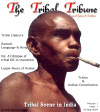Santali: Language and Script
| Introduction | Script |
| Literature | Alchiki |
|
Santali, to be specific, belongs to Munda family of language which is a part of Austric (Austo-Asiatic) language family. The classification of Munda family is displayed as follows.
Santali literature is classified into two main type: (i) the earlier primitive literature based on oral tradition and (ii) the modern literature which is being created by educated Santals on the model of the literature in the Aryan languages, particularly Bengali, Oriya and to some extent Hindi. The second type of literature does not have any special Santali character about it. There are two great works in Santal containing collections of old traditions and legends. The first is Hor-ko-ren mare Harprarn-ko-reak Katha or ‘ The Traditions of the Ancestors of the Hor or Santal people'. The traditions contained in this work were given out by a Santal guru or preacher named Kolean (Kalyan). This oral narration was published by a Scandinavian Missionary Rev. A. S. Skrefrsud in year 1887. It was in roman script. It is a great compilation of Santali stories and legends in their earliest forms. The second work is Kherwal-Vamsa Dharam-Puthi or ‘The sacred Book of the Kherwal Race’ (Kherwal is an old name for the Santals and other allied Kol people. It is a compilation as well as composition by Ramdas Majhi Tudu of Ghatrida (Bihar) who was very well informed about the traditions of his people and its religious and social culture. This book was published in 1902. It was in Bengali script. Next to these myths and religious traditions and usages there is a long series of Santal folk tales dealing mostly with Santal belief in the Bongas or Gods and Godlings, and giving a very fine picture of the primitive life of the Santal people in their jungle villages. The best collections of the such stories were made by Scandinavian Missionaries, particularly by P. O Budding who was considered one of the great authorities on Santal folklore and tradition. It was in Roman script. Besides these folk tales in prose, there is a rich mass of Santal lyrics generally in couplets and sometimes in more than four to six line. In these lyrics, thumbnail sketches of Santali life is found. Santali language to start with, never had any script of its own. Besides being written in Roman script, in West Bengal- Bengali script, in Orissa - Oriya script and in Bihar- Nagari script were used to write Santali language. Pandit Raghunath Murmu has developed a script for Sanatli language which is known as ‘Alchiki’. It is claimed to have been developed as early as 1935–36. Alchiki alphabet has six vowels and twenty four consonants such that every vowel is followed by four consonants with the restriction that a consonant follows one and only one vowel. Besides there are five symbols of signification used after the letters to give different sounds. It may be observed that though the shapes of the letters appear to be a bit complicated, yet they are drawn similar to certain real life situations.
|





